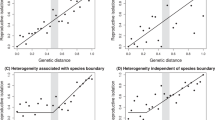Abstract
There is increasing evidence1,2,3,4,5,6 for the process of sympatric speciation7,8, in which reproductive isolation of species occurs without physical isolation. Theoretical models9,10,11,12,13,14 have focused on disruptive natural selection as the crucial pressure for splitting a species. Here we report the theoretical finding that sympatric speciation may be caused by sexual selection even without disruptive natural selection. Specifically, we show that variation in a male secondary sexual character with two conspicuous extremes and the corresponding variance in female mating preference around no preference may jointly evolve into bimodal distributions with increasing modal divergence of the male and female traits, pulling a population apart into two prezygotically isolated populations. This mode of speciation, driven by two runaway processes15,16,17 in different directions, is promoted by an increase in the efficiency of females in discriminating among males or a decrease in the cost of male conspicuousness, indicating that sympatric speciation may occur more readily if barrier-free or predator-free conditions arise. Although even a slight cost of female preference would cancel the runaway process of sexual selection18, it would not cancel the divergent runaway processes of sympatric speciation.
This is a preview of subscription content, access via your institution
Access options
Subscribe to this journal
Receive 51 print issues and online access
$199.00 per year
only $3.90 per issue
Buy this article
- Purchase on Springer Link
- Instant access to full article PDF
Prices may be subject to local taxes which are calculated during checkout



Similar content being viewed by others
References
Turner,G. F. Speciation mechanism in Lake Malawi cichlids: A critical review. Arch. Hydrobiol. 44, 139–160 (1994).
Deutsch,J. C. Colour diversification in Malawi cichlids: evidence for adaptation, reinforcement or sexual selection? Biol. J. Linn. Soc. 62, 1–14 (1997).
Seehausen,O., Alphen,J. J. M. & Witte,F. Cichlid fish diversity threatened by eutrophication that curbs sexual selection. Science 277, 1808–1811 (1997).
Seehausen,O. & Alphen,J. J. M. The effect of male coloration on female mate choice in closely related Lake Victoria cichlids (Haplochromis nyererei complex). Behav. Ecol. Sociobiol. 42, 1–8 (1998).
Ritchie,M. G. & Phillips,S. D. F. in Endless Forms: Species and Speciation (eds Howard, D. J. & Berlocher, S. H.) 291–308 (Oxford Univ. Press, New York, 1998).
Albertson,R. C., Markert,J. A., Danley,P. D. & Kocher,T. D. Phylogeny of a rapidly evolving clade: The cichlid fishes of Lake Malawi, East Africa. Proc. Natl Acad. Sci. USA 96, 5107–5110 (1999).
Tauber,C. A. & Tauber,M. J. in Speciation and its Consequences (eds Otte, D. & Endler, J. A.) 307–344 (Sinauer, Sunderland, 1989).
Bush,G. L. Sympatric speciation in animals: new wine in old bottles. Trends Ecol. Evol. 9, 285–288 (1994).
Maynard Smith,J. Sympatric speciation. Am. Nat. 100, 637–650 (1966).
Tauber,G. A. & Tauber,M. J. A genetic model for sympatric speciation through habitat diversification and seasonal isolation. Nature 268, 702–705 (1977).
Doebeli,M. A quantitative genetic competition model for sympatric speciation. J. Evol. Biol. 9, 893–909 (1996).
Kawecki,T. J. Sympatric speciation via habitat specialization driven by deleterious mutations. Evolution 51, 1751–1763 (1997).
Kodrashov,A. S. & Kondrashov,F. A. Interactions among quantitative traits in the course of sympatric speciation. Nature 400, 351–354 (1999).
Dieckmann,U. & Doebeli,M. On the origin of species by sympatric speciation. Nature 400, 354–357 (1999).
Fisher,R. A. The Genetical Theory of Natural Selection (Clarendon, Oxford, 1930).
Lande,R. Models of speciation by sexual selection on polygenic traits. Proc. Natl Acad. Sci. USA 78, 3721–3725 (1981).
Seger,J. Unifying genetic models for the evolution of female choice. Evolution 39, 1185–1193 (1985).
Pomiankowski,A. The costs of choice in sexual selection. J. Theor. Biol. 128, 195–218 (1987).
Liou,L. W. & Price,T. D. Speciation by reinforcement of premating isolation. Evolution 48, 1451–1459 (1994).
Turner,G. F. & Burrows,M. T. A model of sympatric speciation by sexual selection. Proc. R. Soc. Lond. B 260, 287–292 (1995).
Pomiankowski,A., Iwasa,Y. & Nee,S. The evolution of costly mate preferences I. Fisher and biased mutation. Evolution 45, 1422–1430 (1991).
Iwasa,Y., Pomiankowski,A. & Nee,S. The evolution of costly mate preferences II. The ‘handicap’ principle. Evolution 45, 1431–1442 (1991).
Wu,G.-I. A stochastic simulation study on speciation by sexual selection. Evolution 39, 66–82 (1985).
Acknowledgements
M.H. thanks J. Lawton and the NERC Centre for Population Biology for their hospitality. This work was supported by a MESSC grant to M.H.
Author information
Authors and Affiliations
Corresponding author
Rights and permissions
About this article
Cite this article
Higashi, M., Takimoto, G. & Yamamura, N. Sympatric speciation by sexual selection. Nature 402, 523–526 (1999). https://doi.org/10.1038/990087
Received:
Accepted:
Issue Date:
DOI: https://doi.org/10.1038/990087
This article is cited by
-
Ecological disruptive selection acting on quantitative loci can drive sympatric speciation
npj Systems Biology and Applications (2024)
-
Divergent preference functions generate directional selection in a jumping spider
Scientific Reports (2023)
-
Multilocus phylogeography and ecological niche modeling suggest speciation with gene flow between the two Bamboo Partridges
Avian Research (2021)
-
The emergence of ecotypes in a parasitoid wasp: a case of incipient sympatric speciation in Hymenoptera?
BMC Ecology and Evolution (2021)
-
Genetic relationships of cichlid fishes from Lake Malawi based on mitochondrial DNA sequences
Limnology (2020)
Comments
By submitting a comment you agree to abide by our Terms and Community Guidelines. If you find something abusive or that does not comply with our terms or guidelines please flag it as inappropriate.



